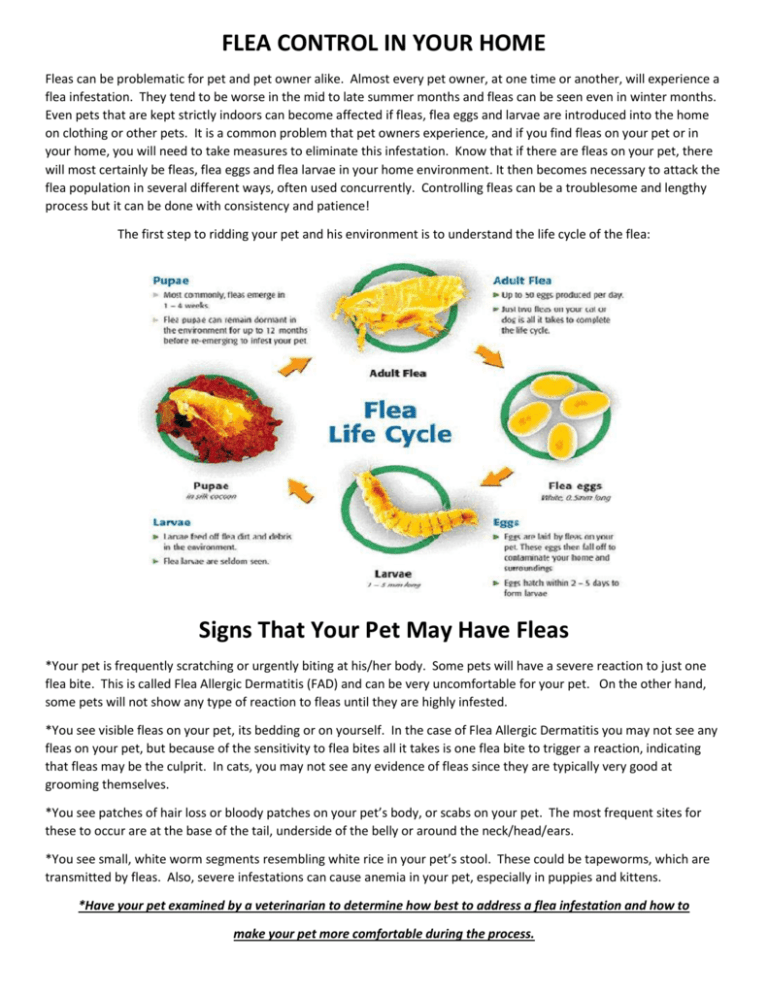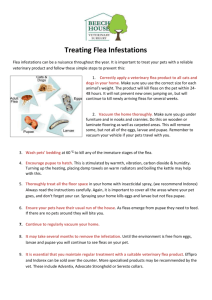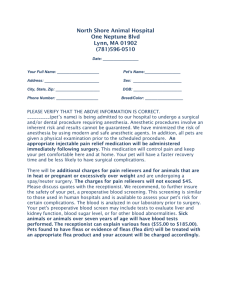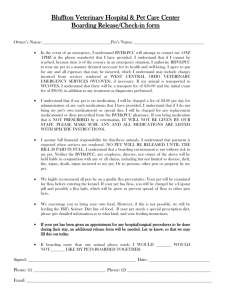Flea Control in Your Home
advertisement

FLEA CONTROL IN YOUR HOME Fleas can be problematic for pet and pet owner alike. Almost every pet owner, at one time or another, will experience a flea infestation. They tend to be worse in the mid to late summer months and fleas can be seen even in winter months. Even pets that are kept strictly indoors can become affected if fleas, flea eggs and larvae are introduced into the home on clothing or other pets. It is a common problem that pet owners experience, and if you find fleas on your pet or in your home, you will need to take measures to eliminate this infestation. Know that if there are fleas on your pet, there will most certainly be fleas, flea eggs and flea larvae in your home environment. It then becomes necessary to attack the flea population in several different ways, often used concurrently. Controlling fleas can be a troublesome and lengthy process but it can be done with consistency and patience! The first step to ridding your pet and his environment is to understand the life cycle of the flea: Signs That Your Pet May Have Fleas *Your pet is frequently scratching or urgently biting at his/her body. Some pets will have a severe reaction to just one flea bite. This is called Flea Allergic Dermatitis (FAD) and can be very uncomfortable for your pet. On the other hand, some pets will not show any type of reaction to fleas until they are highly infested. *You see visible fleas on your pet, its bedding or on yourself. In the case of Flea Allergic Dermatitis you may not see any fleas on your pet, but because of the sensitivity to flea bites all it takes is one flea bite to trigger a reaction, indicating that fleas may be the culprit. In cats, you may not see any evidence of fleas since they are typically very good at grooming themselves. *You see patches of hair loss or bloody patches on your pet’s body, or scabs on your pet. The most frequent sites for these to occur are at the base of the tail, underside of the belly or around the neck/head/ears. *You see small, white worm segments resembling white rice in your pet’s stool. These could be tapeworms, which are transmitted by fleas. Also, severe infestations can cause anemia in your pet, especially in puppies and kittens. *Have your pet examined by a veterinarian to determine how best to address a flea infestation and how to make your pet more comfortable during the process. Control Measures Fleas love to mature in protected areas such as carpet, rugs and bedding, as well as cracks and crevices on couches and chairs. They also need heat and humidity to develop through their life cycles and so warm, protected spaces are ideal for their development. There are several measures that you can take to rid fleas from your environment including: 1) Don’t wait to address a flea problem. The sooner you begin to rid your pet and home of fleas, flea eggs and larvae, the sooner you will achieve this goal. 2) Vacuum carpets and rugs thoroughly every other day to suction up any fleas. You will want to be sure to vacuum areas where carpets or rugs meet the wall as this area typically experiences low foot traffic and is a great place for flea eggs to mature. **Be sure to promptly empty your vacuum canister or remove you vacuum bag once you are done vacuuming and take it to your outside trash; fleas can jump out of inside trash cans back in to the environment. 3) Wash any and all bedding, including your own if your pet sleeps with you. Wash them in hot water every other day at the same time you are vacuuming. Also wash any pillows, cushions and plush toys as you can. 4) Bathe your pet if you notice flea dirt on the pet. However, if you are using a topical flea treatment, DO NOT bathe your pet in flea shampoo as this may cause toxic levels of insecticide to develop in your pet. You can bathe using Dawn shampoo or baby shampoo. *Do not bathe too frequently, however, as this may wash off any topical flea treatment from your pet’s skin, rendering it less effective. You can use a soap-free shampoo if you need to bathe your pet frequently. 5) When coming in from outdoors, be mindful that you may bring hitchhiking fleas into your home through your clothing. Check yourself and shake out your clothing if you have been in wooded or grassy areas. 6) Apply a topical flea treatment such as Advantix, Revolution or Vectra or administer an oral flea preventative at your veterinarian’s direction to begin breaking the flea life cycle. Also make sure that the medication you use is dosed properly for the size of your pet and for the species of your pet. Since most topical and oral flea treatments address only one or a few stages of the flea life cycle, you may need to administer this treatment for several months in conjunction with consistent environmental control measures to fully break the flea life cycle and rid your home of fleas. 7) Treat all pets in your household, not just the pets that you know have fleas. Pets that are not treated could still harbor and re-introduce fleas back into the environment, even if you are taking measures to rid your home of fleas. Please do not be discouraged! Consistency is key to success! **Consult with your veterinarian as to which flea treatment is most appropriate for your pet and how often to administer it. Please be aware that over-the-counter topical flea treatments can be less effective than treatments you can get from your veterinarian and can also cause localized irritation at the site of application. Utilize flea preventatives year-round at the direction of your veterinarian, especially in warmer climates that do not see deep freezes in winter that serve to kill off flea populations. PLEASE NOTE: Do not give ANY flea treatment to a cat that is labeled for a dog! This can have toxic, even fatal effects on a cat! Please read all labels carefully before applying any product to your pet! With consistent attention, you can eliminate fleas from your pet and your home.




